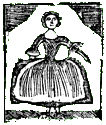 I’ve felt like I’ve been neglecting half of colonial Boston’s population. Not the children (who were more than half, and whom I spend extra time on). I mean the females. So between now and “Pope Night,” I’ll try to focus on a few women’s stories.
I’ve felt like I’ve been neglecting half of colonial Boston’s population. Not the children (who were more than half, and whom I spend extra time on). I mean the females. So between now and “Pope Night,” I’ll try to focus on a few women’s stories.Of course, those stories often come to light because of the women’s relationships with men, who conducted most of the public business of the times and therefore got into documentary records more often. And that’s the case with my first subject: Elizabeth Henderson.
On 2 Sept 1769 at Trinity Church in Boston, Elizabeth Henderson married “James Hartigan a Soldier of the 29th.” I don’t know where or when she was born, or how the couple had met.
Had Elizabeth come down from Halifax with that army regiment? Was she a Massachusetts woman who fell in love with a soldier? Did she grow up in Boston, or move to the town from the countryside or Britain? Was she part of the mainstream English, Congregationalist society, or was she already in some ways an outsider? She did, after all, marry an Irish soldier in an Anglican church. Was this her first marriage?
The following 5 March, Pvt. Hartigan was sent by Capt. Thomas Preston to reinforce the sentry outside the Customs office on King Street. An angry crowd was throwing snowballs because that sentry had clubbed an apprentice earlier in the evening. By the end of the night, Hartigan and most of his comrades had fired their muskets, and five civilians were dead or dying. The next day, Hartigan and his colleagues were arrested for what locals called a "Massacre."
Hartigan remained in jail through spring and summer. His regiment was withdrawn to Castle William in the harbor and then redeployed to New Jersey. On 4 May a Boston official “warned out” Elizabeth. The record of that warning appears in The Legal Papers of John Adams:
Elisabeth Hartick a Soldiers Wife Lodges att Mr Hiklans in Kings Street he is one of the 29 Rajment Now in Goal in Boston to be tryed for the murder of the people in Kings Street the Last March Warned in his Majestys Name to Depart this town of Boston in 14 days.“Warning out” wasn’t quite as unwelcoming as it sounds. Officials didn’t actually force anyone to leave. But by telling a head of household to do so, they absolved the town of financial responsibility if that family became too indigent or sick to take care of themselves.
In the case of Elizabeth Hartigan, this notice tells us that she did not have any children or other relatives living with her in mid-1770. Otherwise, they would have been listed as well.
I suspect that the “John Hiklan” she was lodging with was John Hickling, who left a deposition about what he'd seen at the Massacre and was mentioned by a couple of other witnesses. For example, Joseph Hillyer told the court during the soldiers’ trial, “A little boy, at Mr. Hicklings told me People were kill’d.” If Elizabeth had been in Hickling’s house in March, therefore, she would have been within earshot of the riot and shootings.
SPOILER
Pvt. Hartigan was acquitted of all charges in Nov 1770, and rejoined the 29th in New Jersey. The last record of him is on the regiment’s muster roll dated 30 April 1772 in St. Augustine, Florida. It lists James Hartigan as “Deceased 4th. Nov 1771.”
What happened to Elizabeth? Again, I don’t know. But I’ll note that at St. John’s Church in Essex, New Jersey, an Elizabeth Hartigan married James Brown on 5 Jan 1772. They were both said to be “of New York.” I wouldn’t even suggest that this was the soldier’s widow, quickly remarrying, except that the very next wedding on that church register is “John Burnet to Margaret Weeks, both of 29th Regt.,” on 16 Feb, and a man from the 29th had married there in the previous March as well. So that was where people associated with the 29th went to marry, and a new marriage for Elizabeth is a nice possibility to contemplate. But good luck to anyone trying to track down an "Elizabeth Brown" in New York!
No comments:
Post a Comment